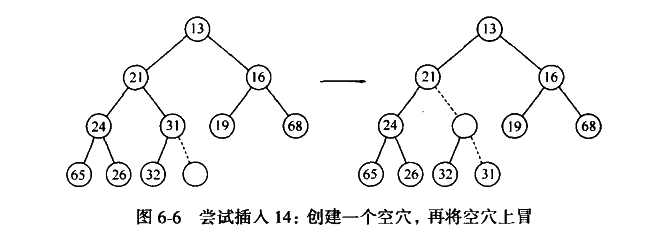JAVA数据结构--优先队列(堆实现)
优先队列(堆)的定义
堆(英语:Heap)是计算机科学中一类特殊的数据结构的统称。堆通常是一个可以被看做一棵树的数组对象。在队列中,调度程序反复提取队列中第一个作业并运行,因为实际情况中某些时间较短的任务将等待很长时间才能结束,或者某些不短小,但具有重要性的作业,同样应当具有优先权。堆即为解决此类问题设计的一种数据结构。
我个人比较通俗的理解就是比如我们平常下载视频看,我们打算下载两部视频,一部2G,一部只有200M。优先队列的思想就是先下载那部体积较小的视频,这样也比较合理,可以下完200M后看的同时再下2G的视频。

堆是一颗被完全填满的二叉树,唯一可能的例外是在最底层。所以堆具有两个性质——堆序性和结构性。一个高为h的完全二叉树有2h或2h-1个节点,并且堆中每一个节点X的父亲的值小于或等于X中的关键字,所以堆的最小值总可以在根中找到。
堆的构造实现
private static final int DEFAULT_CAPACITY=10;//定义堆的大小
private int currentSize;//当前实际堆的大小
private T [] array; //数组表示堆中元素
public BinaryHeap(int capacity) {//初始化堆数组
currentSize=0;
array=(T[])new Comparable[capacity+1];
}
public BinaryHeap(T[] items) {
currentSize=items.length;
array=(T[])new Comparable[(currentSize+2)*11/10];
int i=1;
for(T item:items)
array[i++]=item;//堆数组赋值
buildHeap();
}
private void buildHeap() {
for(int i=currentSize/2;i>0;i--)//逐层下滤
percolateDown(i);
}
注意!用数组实现堆时,元素的下标是从1开始,不是从0开始。原因是因为当插入的元素是比堆顶还小的元素时,我们不需要对堆做任何操作即可把堆冒出。
元素插入
public void insert(T x) {
if(currentSize==array.length-1)
enlargeArray(array.length*2+1);//堆扩容
int hole=++currentSize; //空穴表示的数组下标
/*
* hole/2是当前空穴的父节点的数组下标,如果x比父节点的元素小,则父节点元素下沉,空穴上冒
* */
for(array[0]=x;x.compareTo(array[hole/2])<0;hole/=2)
array[hole]=array[hole/2]; //元素交换
array[hole]=x;
}


删除最小元
删除最小元基本的思想是将最小元置为空穴,再将堆的最后一个元素放入其中,则此时的堆是不合法的,我们需要做的就是将此时的堆顶元素下沉到合适的位置。
public T deleteMin() throws Exception {
if(isEmpty())
throw new Exception();
T minItem=findMin();//获取最小元
array[1]=array[currentSize--];//取出最后一个元素
percolateDown(1);//元素下滤
return minItem;
}
private void percolateDown(int hole) {//下滤元素
int child;
T tmp=array[hole];
for(;hole*2<=currentSize;hole=child) {
child=hole*2;//孩子节点的下标
if(child!=currentSize&&
array[child+1].compareTo(array[child])<0)//找出较小的孩子节点
child++;
if(array[child].compareTo(tmp)<0)//逐层下滤
array[hole]=array[child];//元素替换
else
break;
}
array[hole]=tmp;
}

全部代码实现(数据结构与算法分析中的demo)
// BinaryHeap class
//
// CONSTRUCTION: with optional capacity (that defaults to 100)
// or an array containing initial items
//
// ******************PUBLIC OPERATIONS*********************
// void insert( x ) --> Insert x
// Comparable deleteMin( )--> Return and remove smallest item
// Comparable findMin( ) --> Return smallest item
// boolean isEmpty( ) --> Return true if empty; else false
// void makeEmpty( ) --> Remove all items
// ******************ERRORS********************************
// Throws UnderflowException as appropriate /**
* Implements a binary heap.
* Note that all "matching" is based on the compareTo method.
* @author Mark Allen Weiss
*/
public class BinaryHeap<AnyType extends Comparable<? super AnyType>>
{
/**
* Construct the binary heap.
*/
public BinaryHeap( )
{
this( DEFAULT_CAPACITY );
} /**
* Construct the binary heap.
* @param capacity the capacity of the binary heap.
*/
public BinaryHeap( int capacity )
{
currentSize = 0;
array = (AnyType[]) new Comparable[ capacity + 1 ];
} /**
* Construct the binary heap given an array of items.
*/
public BinaryHeap( AnyType [ ] items )
{
currentSize = items.length;
array = (AnyType[]) new Comparable[ ( currentSize + 2 ) * 11 / 10 ]; int i = 1;
for( AnyType item : items )
array[ i++ ] = item;
buildHeap( );
} /**
* Insert into the priority queue, maintaining heap order.
* Duplicates are allowed.
* @param x the item to insert.
*/
public void insert( AnyType x )
{
if( currentSize == array.length - 1 )
enlargeArray( array.length * 2 + 1 ); // Percolate up
int hole = ++currentSize;
for( array[ 0 ] = x; x.compareTo( array[ hole / 2 ] ) < 0; hole /= 2 )
array[ hole ] = array[ hole / 2 ];
array[ hole ] = x;
} private void enlargeArray( int newSize )
{
AnyType [] old = array;
array = (AnyType []) new Comparable[ newSize ];
for( int i = 0; i < old.length; i++ )
array[ i ] = old[ i ];
} /**
* Find the smallest item in the priority queue.
* @return the smallest item, or throw an UnderflowException if empty.
*/
public AnyType findMin( )
{
if( isEmpty( ) )
throw new UnderflowException( );
return array[ 1 ];
} /**
* Remove the smallest item from the priority queue.
* @return the smallest item, or throw an UnderflowException if empty.
*/
public AnyType deleteMin( )
{
if( isEmpty( ) )
throw new UnderflowException( ); AnyType minItem = findMin( );
array[ 1 ] = array[ currentSize-- ];
percolateDown( 1 ); return minItem;
} /**
* Establish heap order property from an arbitrary
* arrangement of items. Runs in linear time.
*/
private void buildHeap( )
{
for( int i = currentSize / 2; i > 0; i-- )
percolateDown( i );
} /**
* Test if the priority queue is logically empty.
* @return true if empty, false otherwise.
*/
public boolean isEmpty( )
{
return currentSize == 0;
} /**
* Make the priority queue logically empty.
*/
public void makeEmpty( )
{
currentSize = 0;
} private static final int DEFAULT_CAPACITY = 10; private int currentSize; // Number of elements in heap
private AnyType [ ] array; // The heap array /**
* Internal method to percolate down in the heap.
* @param hole the index at which the percolate begins.
*/
private void percolateDown( int hole )
{
int child;
AnyType tmp = array[ hole ]; for( ; hole * 2 <= currentSize; hole = child )
{
child = hole * 2;
if( child != currentSize &&
array[ child + 1 ].compareTo( array[ child ] ) < 0 )
child++;
if( array[ child ].compareTo( tmp ) < 0 )
array[ hole ] = array[ child ];
else
break;
}
array[ hole ] = tmp;
} // Test program
public static void main( String [ ] args )
{
int numItems = 10000;
BinaryHeap<Integer> h = new BinaryHeap<>( );
int i = 37; for( i = 37; i != 0; i = ( i + 37 ) % numItems )
h.insert( i );
for( i = 1; i < numItems; i++ )
if( h.deleteMin( ) != i )
System.out.println( "Oops! " + i );
}
}
JAVA数据结构--优先队列(堆实现)的更多相关文章
- Java数据结构之堆和优先队列
概述 在谈堆之前,我们先了解什么是优先队列.我们每天都在排队,银行,医院,购物都得排队.排在队首先处理事情,处理完才能从这个队伍离开,又有新的人来排在队尾.但仅仅这样就能满足我们生活需求吗,明显不能. ...
- java数据结构之(堆)栈
(堆)栈概述栈是一种特殊的线性表,是操作受限的线性表栈的定义和特点•定义:限定仅在表尾进行插入或删除操作的线性表,表尾—栈顶,表头—栈底,不含元素的空表称空栈•特点:先进后出(FILO)或后进先出(L ...
- Java数据结构和算法(四)赫夫曼树
Java数据结构和算法(四)赫夫曼树 数据结构与算法目录(https://www.cnblogs.com/binarylei/p/10115867.html) 赫夫曼树又称为最优二叉树,赫夫曼树的一个 ...
- Java数据结构和算法(十四)——堆
在Java数据结构和算法(五)——队列中我们介绍了优先级队列,优先级队列是一种抽象数据类型(ADT),它提供了删除最大(或最小)关键字值的数据项的方法,插入数据项的方法,优先级队列可以用有序数组来实现 ...
- Java数据结构和算法 - 堆
堆的介绍 Q: 什么是堆? A: 这里的“堆”是指一种特殊的二叉树,不要和Java.C/C++等编程语言里的“堆”混淆,后者指的是程序员用new能得到的计算机内存的可用部分 A: 堆是有如下特点的二叉 ...
- java数据结构和算法10(堆)
这篇我们说说堆这种数据结构,其实到这里就暂时把java的数据结构告一段落,感觉说的也差不多了,各种常见的数据结构都说到了,其实还有一种数据结构是“图”,然而暂时对图没啥兴趣,等有兴趣的再说:还有排序算 ...
- java数据结构----堆
1.堆:堆是一种树,由它实现的优先级队列的插入和删除的时间复杂度都是O(logn),用堆实现的优先级队列虽然和数组实现相比较删除慢了些,但插入的时间快的多了.当速度很重要且有很多插入操作时,可以选择堆 ...
- Java数据结构和算法 - 栈和队列
Q: 栈.队列与数组的区别? A: 本篇主要涉及三种数据存储类型:栈.队列和优先级队列,它与数组主要有如下三个区别: A: (一)程序员工具 数组和其他的结构(栈.队列.链表.树等等)都适用于数据库应 ...
- Java之优先队列
PriorityQueue属于Java Collections Framework.PriorityQueue基于优先级堆,它是Queue接口的实现.当我们需要一个Queue实现时,可以使用这种数据结 ...
随机推荐
- Docker 实现的 redis 主从
计划用 Docker 实现 Redis 的主从,简单主从而已.主的名称叫 redis-master 一步步来. 先新建个Dockerfile ,从alpine 开始,比较简单. FROM alpine ...
- spring 获取 WebApplicationContext的几种方法
spring 获取 WebApplicationContext的几种方法 使用ContextLoader WebApplicationContext webApplicationContext = C ...
- [原创]升级SOUI WKE以支持_blank
由于WKE的精简模式,导致原有的SOUI不支持针对诸多内容的调用,此处针对WKE的部分内容做升级,以支持对应的功能. 目的:使WKE可以_blank弹出新窗口. 由国人 海绵宝宝维护的WKE新分支:h ...
- 8) Struts2 2 SpringMVC
git@github.com:witaste/smse.git 数据库脚本: /* Navicat MySQL Data Transfer Source Server : 新服务器 Source Se ...
- ssh关于含有外键的传值中无法识别正确的action的原因和解决办法
在含有外键的表中,要保存一个值到这个外键时:逻辑思路:需要先将jsp页面的值传到相应的action中,在这个action中需要引入这个外键的实体层和DAO层(DAO层只需set方法),在执行函数中对于 ...
- 【转】java中定义二维数组的几种写法
原文链接 注:以下的 type[][] var 也可以这样申明 type var[][] type为数组的类型,var为变量名 写法一:行列固定的数组 //定义二维数组写法1 class Test { ...
- 【小梅哥SOPC学习笔记】切换NIOS II CPU的主内存后软件中需要注意的几点设置
切换NIOS II CPU的主内存后软件中需要注意的几点设置 有时候,我们可能面对这样一种情况: 1. 我们创建一个SOPC系统,并在QSYS中设置NIOS II的复位地址和异常地址都指向SRAM: ...
- laravel中使用mgirations创建和迁移数据库
使用php artisan make:migration create_links_table命令 编辑2016_04_11_095342_create_links_table public func ...
- Android-bindService远程服务(Aidl)-传递对象
之前上一篇讲解到本地服务,本地服务只能在自身APP中Activity访问Service,调用Service里面到方法等操作 如果想A应用访问B应用里面的方法,属于跨进程调用,如果Android不特供这 ...
- Web界面设计(Designing Web Interfaces中文版) (美)斯科特 pdf扫描版
Web界面设计是由Bill Scott编著.电子工业出版社出版的一部图书,在Web已经进入崭新的时代的今天,界面的设计显得非常重要,本书就是基于独一无二的Web环境下.在创建丰富体验的过程中设计Web ...
